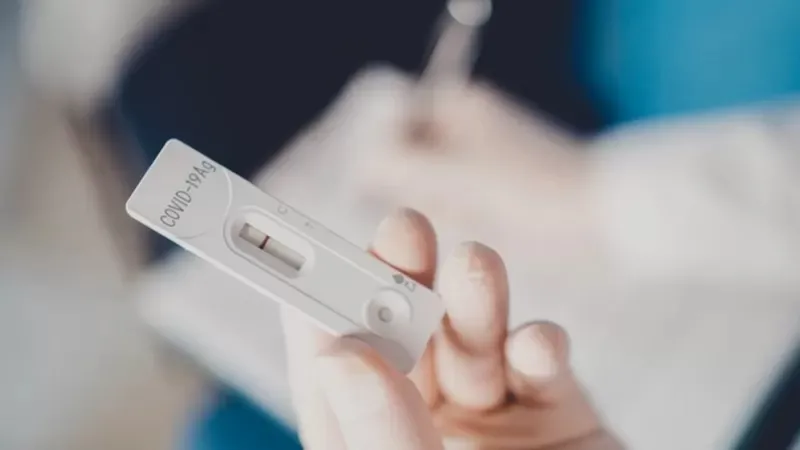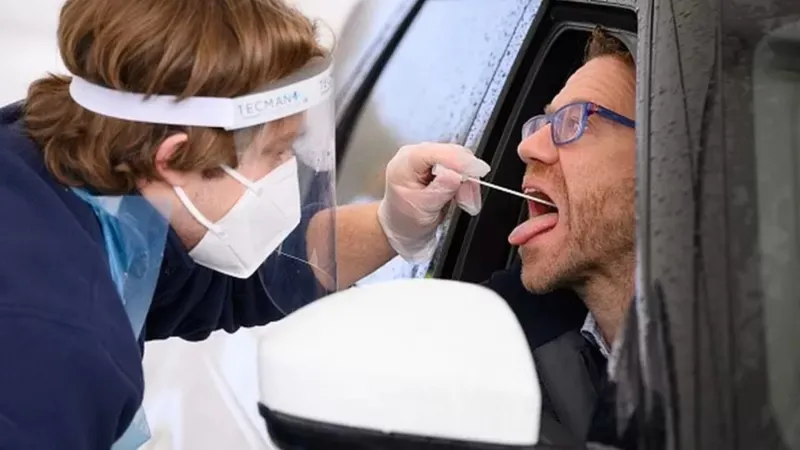The advancement of the omicron variant is one of the main factors behind the impressive increase in the number of new COVID-19 cases registered in various parts of the world.
But what can a person who has symptoms of covid, such as fever, cough, tiredness, loss of taste or smell, pain and diarrhea, do to find out if they have the disease? What tests are indicated?
We explain below the most common tests and what are the advantages and disadvantages of each of them.
RT-PCR: high degree of confidence, but the result takes time
This test is considered the “gold standard” by the World Health Organization (WHO).
In practice, this means that it gives the most reliable results and defines whether an individual has COVID-19 or not.
Performed with a nasal and oral swab, in which a flexible cotton swab is rubbed at the tip at the back of the nose and mouth to collect a sample from the patient, this test can detect the presence of the genetic material of the coronavirus .
Laboratories generally advise that the sample be taken between the third and seventh day after the onset of symptoms.
This is because RT-PCR detects RNA (the genetic material of the virus), and that time window is the period of infection when there is greater viral activity and it is easier to find the cause of covid-19 in the background of the throat.
However, in some cases, your doctor may order this test to be done on the first or even the tenth day of symptoms.

The RT-PCR test requires well-trained professionals and more complex equipment.
Despite the high degree of reliability, this option also has some disadvantages: it is more expensive and the report with results can take more than a day to be ready.
“Furthermore, RT-PCR is a method that requires highly trained professionals and highly complex equipment, which are not readily available in all laboratories,” stated pathologist Wilson Shcolnik, president of the board of directors of the Brazilian Association of Diagnostic Medicine. (Abramed).
Still in the field of molecular testing, some laboratories and pharmacies also offer the PCR-Lamp . It also investigates the presence of viral RNA in saliva, but its result is not considered as accurate as that obtained in RT-PCR .
“The Lamp can be a good alternative when RT-PCR is not available,” suggested Shcolnik.
Another option, which has become more popular recently with the H3N2 flu epidemic, is called viral panels .
These tests are able to analyze and differentiate if the person is infected by coronavirus, influenza (which causes flu) and respiratory syncytial virus (one of the causes of the cold), among other pathogens.
Antigens: less certain results, but accessibility is in favor
Also known as a rapid test, health agencies and experts consider this method “less sensitive.”
In other words, this means that your results are slightly less reliable compared to RT-PCR .
The false negative rate, when the test says that the person is not infected with the covid virus but actually has the disease, is slightly higher in antigen tests.
To alleviate this degree of uncertainty, many sites and institutions recommend repeating the s antigen test for several consecutive days (sometimes for an entire week).
Thus, it is possible to guarantee the detection of the coronavirus at some stage of the infectious process, if it is actually found in the body of that individual.
Among its advantages, we can highlight the lower price and the speed of the result – as the popular name of this method already says, it is possible to know if the test is positive or negative in 15 to 30 minutes .
“Antigen tests are capable of delivering the result in a shorter period of time, without the need to centralize samples and reports. They can be very useful in a situation of high demand,” said infectologist Carolina Santos Lázari, from the Fleury Group, a private group of diagnostic medicine.
These tests provide important support for an early and rapid diagnosis, capable of interrupting the chains of transmission of the virus in the community, “the doctor added.

Antigen tests give results in less than half an hour.
This test is also done with a nasal and oral swab, which collects material from the back of the mouth and nose.
Unlike RT-PCR, which evaluates the presence of genetic material, the antigen test looks for the N protein in the sample .
Lázari explained that the “N” comes from the nucleocapsid, one of the structures that make up the coronavirus.
Here again, there is an ideal window to perform the test: for greater precision in the result, it should be done three days after the onset of symptoms .
“This waiting time is desirable because the patient may have a lower viral load in the first days , which reduces the sensitivity of the antigen test and can lead to a false negative result,” explained the infectologist Alberto Chebabo, from Dasa, a network of laboratories, hospitals and other private health services.
“That is to say: if the individual undergoes an antigen test as soon as he feels the first symptoms and the result is negative, this does not totally exclude the possibility of a later diagnosis of covid”, clarified the doctor, who is also director of the Clementino Fraga Filho University Hospital, of the Federal University of Rio de Janeiro (UFRJ).
When to perform these tests?
Basically, there are two situations that require an test to diagnose or rule out covid-19.
The first is when a person has one or more of the typical symptoms of the disease , which can be seen in the following list:
• Fever
• Tos
• Fatigue
• Loss of taste or smell
• Throat pain
• Headache
• Body pain
• Diarrhea
• Irritation of the skin or eyes
The second is when the person has had close contact with someone who suspects or has been diagnosed with covid .
“Some countries also have policies to distribute the tests as a form of screening, with the aim of identifying patients without symptoms and isolating them early, before they continue transmitting the virus,” Chebabo added.
What to do before and after the test?
If you have the typical symptoms of covid, the ideal is to remain isolated, even before taking the test, or if you cannot take the test due to lack of availability.
By avoiding contact with other people, you reduce the risk of transmitting the virus and creating new chains of transmission among your close contacts.
After the test, the recommendations of what to do will depend a lot on the result.
If it is negative (that is, you do not have covid), it is possible to resume activities, following basic precautions, such as wearing masks, avoiding crowds and r t e vaccination (if you have not completed the two or three dose regimen yet).
But remember that you should always weigh this result, especially if you have had an antigen test, where the risk of a false negative is higher.
This precaution should be increased if symptoms suggestive of respiratory infections persist. In addition to the risk of false negatives, there is also the probability that you have the flu, another illness that can also be very serious.
In some cases, it may be necessary to repeat the test a few days later, following the advice of a healthcare professional.
Now, if the result is positive (which means that you have covid), you must take other measures that protect your own health and that of everyone around you .
In addition to isolation, it is important to notify close contacts, monitor symptoms, rest, improve hydration, and go to a hospital if discomfort worsens.

